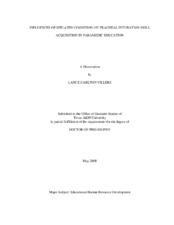| dc.description.abstract | Situated cognition argues that learning takes place in an embedded social and physical
environment, and through a social process, reality takes on meaning. This dissertation
investigated if a link exists between learners’ participation and advancement within a
sociocultural community of practice as specifically evidenced by higher rates of tracheal
intubations on live patients and scores on the national certifying examination by paramedics.
During 2006, paramedic students taking the national certifying examination were asked to
answer a post-examination questionnaire quantifying the number of intubations performed
during training. For intubation experience, significant odds ratios (relative to none performed)
were observed for 4 to 9 performed [OR = 1.66, 95% c.i. = (1.24, 2.23)] and 16 or more
performed [OR = 1.76, 95% c.i. = (1.21, 2.56)]. The male to female odds ratio [OR = 1.25, 95%
c.i. = (1.04, 1.52)] was significant. For age category, significant odds ratios (relative to 40 and
over) were observed for 20 to 24 [OR = 1.70, 95% c.i. = (1.27, 2.28)] and 25 to 29 [OR = 1.32,
95% c.i. = (1.00, 1.73)]. For education, the bachelor’s degree to high school odds ratio [OR =
2.56. 95% c.i. = (1.95, 3.35)] was significant. For ethnicity, significant odds ratios (relative to
African-Americans) were observed for whites [OR = 1.69, 95% c.i. = (1.04, 2.74)] and others
[OR = 2.33, 95% c.i. = (1.15, 4.72)].The multivariable logistic regression model results suggest that the number of tracheal intubations, sex, ethnicity and education level are all associated with
greater odds of passing the certifying examination.
In addition to traditional classroom lectures and activities, paramedic students also learn
in clinical situations with varying levels of supervision culminating in near independent practice.
Theories of situated cognition provide insight into these clinical learning situations that break
from traditional models. When context, content, and community merge, knowledge is generated
in new and meaningful ways. By participating in communities of practice, knowledge is
transferred, created, and altered along with the learner through active engagement with all the illstructured,
dynamic, and unpredicted opportunities the ‘real world’ offers. The students’
exposure to live tracheal intubations during training serve as an example of situated learning
environments and its influence can be observed through the national certifying examination.
The findings provide guidance for paramedic educators in creating situative learning
affordances and specifically, determining the number of tracheal intubations performed during
paramedic training. | en |


